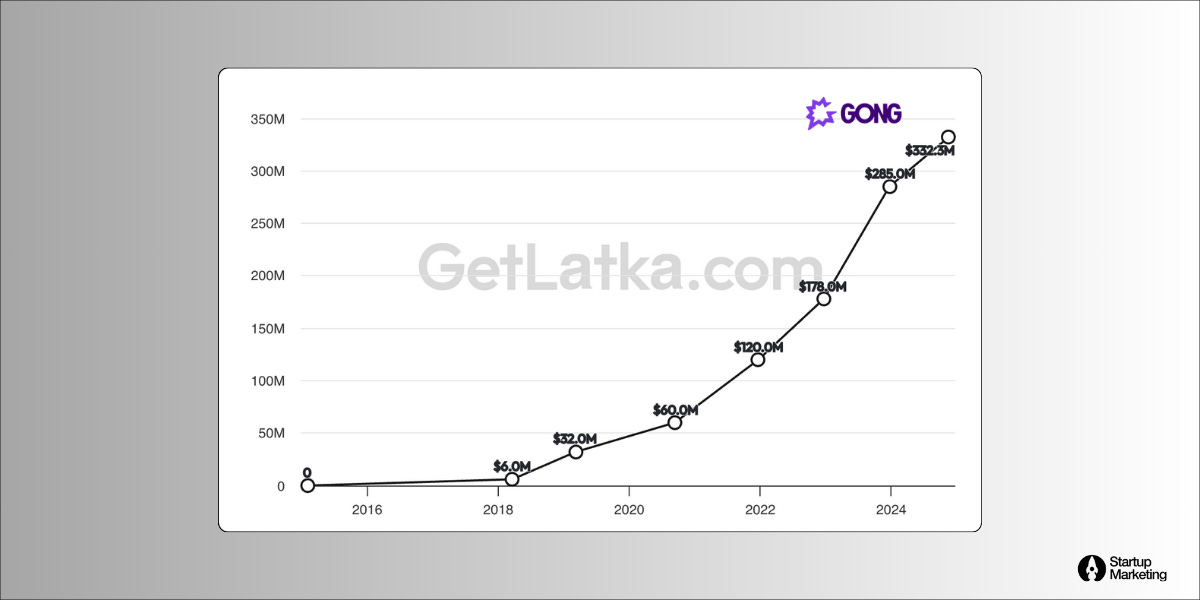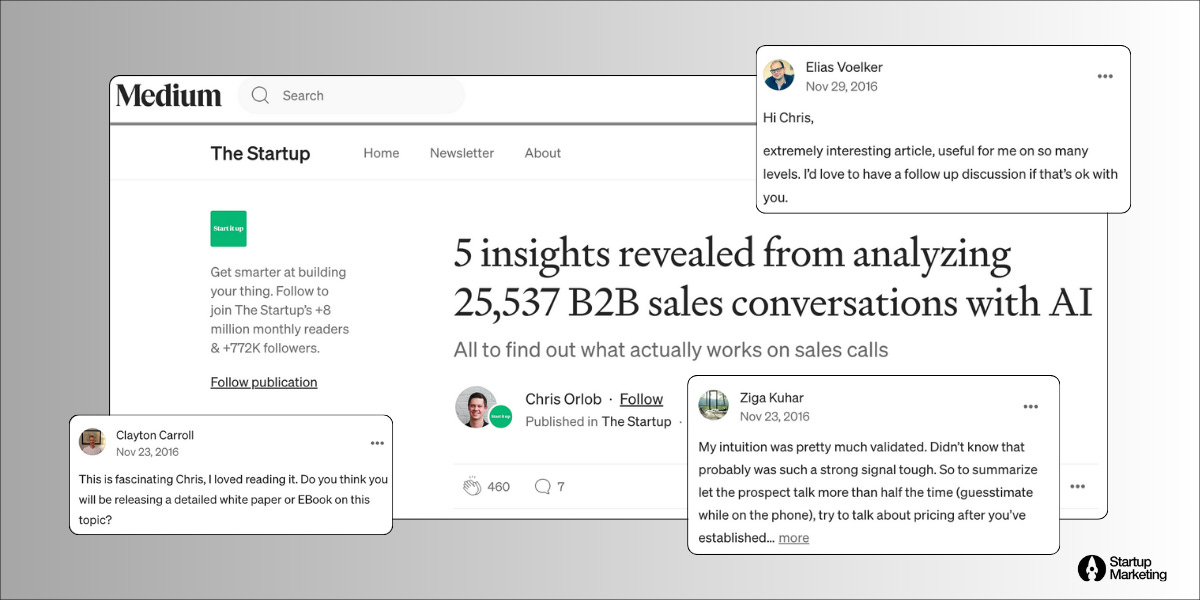Gong's $0 to $1 Million ARR Marketing Strategy
By turning sales insights into viral content, Gong built demand, credibility, and a loyal audience - without relying on traditional branding or paid ads.
👋 Hey, it’s Elan. Welcome to my weekly newsletter, where every week I pick one successful SaaS startup and break down how it grew from $0 to $1 million in ARR. I specifically focus on their marketing strategies - where they started, what worked, and how they executed it.
In my quest to understand how SaaS products targeting mid-market and enterprise companies approach early-stage marketing, I analyzed Gong.io this week.
To address the elephant in the room - yes, content marketing played a huge role in their growth, and nothing I found suggests otherwise. But I focused on how they executed it and the key decisions that made their strategy work.
I’ve also skipped Gong’s branding campaigns since those came later—around 2019—when they had already crossed $1M+ ARR. Bold moves like employee billboards and Super Bowl ads certainly fueled further growth, but they weren’t critical in the early days.
About Gong
Gong is a revenue intelligence platform. It was launched as a conversational intelligence platform that helped sales leaders review sales conversations at scale and coach their teams.
They achieved $1 million in revenue within 12 months of their public launch. Currently, they are at $300 million ARR with 5,000+ customers. Gong is valued at $7.25 billion.
The Team
Amit Bendov and Eilon Reshef co-founded Gong.
The Premise
Gong entered a new category - conversation intelligence for sales.
The majority of their audience was not actively looking for a solution, as people weren’t even aware that a solution existed for their problem.
Gong needed to differentiate itself as a one-of-a-kind tool, rather than being seen as just another sales enablement or coaching software.
Their target persona were sales and revenue leaders.
Lean marketing team (with just 3 members).
Marketing Strategy
Considering they entered a new category with a complex solution, Gong’s marketing strategy was to educate sales leaders about the problem it solved to build trust and credibility for their brand and product.
So how did they go about it?
Evangelised sales conversation intelligence.
Focused on good old outbound cold calling.
Hired a product marketer with sales background.
Created Gong Labs, a data-backed content series.
Focused on one distribution channel.
Stayed on top of the mind through email nurturing.
Contextually outreached to targeted companies.
Outbound to Target List
Before they got traction through content marketing, they focused on cold outbound campaigns to a targeted list of accounts which matched their ideal customer profile.
Amit Bendov onboarded Brendon Cassidy as Gong’s sales advisor/consultant. It was a great decision because Brendon was already passionate about the concept of conversation intelligence for sales and been very vocal in the sales forums.
Brendon helped Gong with their go-to-market motion and helped them close the first 50 customers. The outbound efforts helped Gong gain initial traction before their content marketing efforts gained momentum.
We had a list of companies we knew were our ideal customer profiles, and we did some outbound sales." – Amit Bendov, CEO & Co-Founder, Gong.io
Sales Manager as Product Marketer
Similar to how Figma hired designers as Design Advocates for their GTM team, Gong brought in Chris Orlob as its product marketer. Again a great hiring decision!
Prior to joining Gong, Chris was a regional sales manager before founding a conversational analytics software, Conversature, similar to Gong. So, when he decided to shut down his product, Amit reached out to him and onboarded him as the ‘Director of Product Marketing’.
Chris’s sales background made a significant difference in Gong’s growth and content strategy. Having been a salesperson himself, he deeply understood the challenges, needs, and mindset of Gong's target audience - sales professionals.
Hiring people who have "walked in the shoes of your target audience" is crucial for creating effective content.
- Udi Ledergor, Chief Evangelist (Former CMO), Gong.
It especially helped Gong in making the best out of data-backed sales insights. Chris’s deep understanding of their ICP helped him to build compelling stories using raw data that resonated with sales executives.
Content Strategy
Gong’s content strategy mirrored its product, which analyzed customer conversations to provide data-backed sales insights.
Their first major initiative was a data-driven ebook, but Chris Orlob saw its viral potential and pushed to ungate the content, turning it into publicly accessible articles. The first piece, published across multiple platforms, received overwhelming engagement, shares, and replies.
Why did it work? Sales advice had traditionally been opinion-based—Gong provided hard data, and people wanted more. This success led to Gong Labs, a dedicated content series focused on helping sales professionals close more deals.
Rather than chasing volume, they prioritized quality over quantity, publishing just 1–2 high-impact articles per month for two years—cementing their reputation as thought leaders.
Content Distribution
Gong’s first data-backed article was published in SalesHacker, Medium Publications (related to sales), LinkedIn, and few other websites.
Later they zeroed down on LinkedIn as their primary content distribution channel.
Why LinkedIn?
Sales professionals spend most of their time there - for education, prospecting, networking, hiring, and job hunting.
Email List and Nurturing
People found each piece of content shared through Gong Lab’s valuable and super actionable. It made them to sign up to Gong’s email list to stay up to date with data-driven sales insights.
As they started building the email list, Gong used email as the second distribution channel to share their latest data driven long form content.
It helped them to nurture leads, build trust, and position Gong as a thought leader in the sales space.
So, by the time leads were ready to buy, they were already raving fans of Gong and people directly reached out to the sales team for demo and quotes.
Contextual Sales Outreach
In addition to email nurturing, Gong’s SDR team did contextually outreached to individuals based on the content they engaged with.
If someone interacted with a sales cheat sheet, instead of a generic cold call, an SDR could reference the material, leading to warmer conversations and a higher likelihood of engagement.
For example:
"Hey Ty, I noticed you downloaded our cheat sheet about Zoom calls yesterday. I wanted to see if it was helpful and if I can answer any questions."
This approach made Gong’s outbound efforts much more effective, as SDRs could initiate conversations on a pretext rather than calling out of the blue.
Wrapping up
Gong’s growth was driven primarily by content marketing and outbound efforts. Their content strategy wasn’t just about building brand awareness - it also generated demand.
Looking back, Gong’s strategy might seem simple and methodical. But I doubt they had it all figured out on day one. It wasn’t a straightforward playbook like:
Build a sales intelligence product
Use the product to create marketing content
Hire a sales manager to write and distribute it
Instead, their success came from hiring the right people, deeply understanding their target persona, and continuously iterating to identify high-leverage growth opportunities. Once they found what worked - Gong Labs - they doubled down.
Unlike other companies we’ve analyzed, Gong achieved virality through content. The takeaway? Find virality within your GTM motion, whether through product (Figma, Flodesk), content (Gong), or demo (Webflow).









